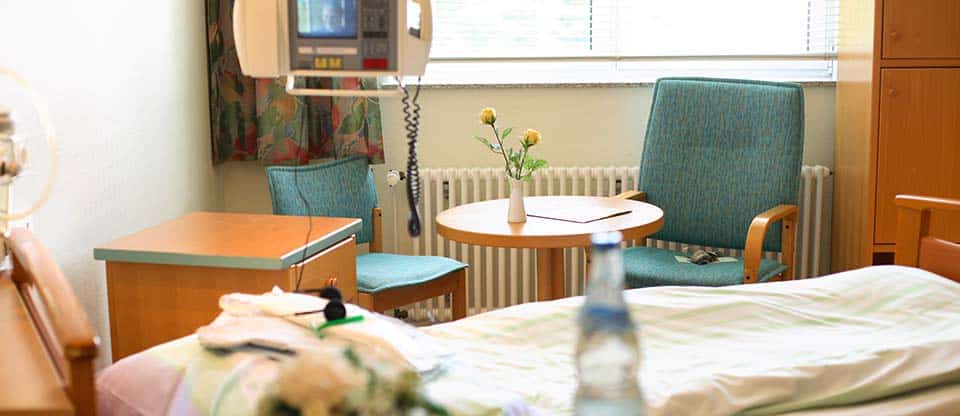The clinic of thoracic surgery treats benign and malignant neoplasms, diseases of the pleura and pleural cavity, mediastinal organs and diaphragm.
The clinic presents the whole range of modern possibilities of thoracic surgery: operations on the open chest, minimally invasive interventions, treatment of metastases by means of laser surgery, correction of bone deformities of the chest, normalization of the function of the sweat glands.
Comprehensive diagnosis and specialized treatment of this group of diseases require high surgical professionalism and close cooperation with doctors of other specialties. The Multidisciplinary Center for Pulmonary Diseases has all the conditions for the joint work of the pulmonology clinic, the clinic of hematology and oncology, radio (CT and MRI), radiology and highly specialized department of nuclear (PET-CT) medicine, the Institute of Pathology and Microbiology. Interdisciplinary conferences are held every week, where doctors from all diagnostic and treatment departments develop individual tactics for treating a patient.
Surgical treatment of tumors
About 70% of all operations performed in the clinic are aimed at removing benign and malignant tumors of the lungs, bronchi, pleura, mediastinum or chest wall. Removal of a lobe of the lung (lobectomy), the entire lung (pneumoectomy) in combination with excision of the vascular bundle from the pericardium, excision of the vascular-bronchial cuff followed by reconstructive plastic surgery, operations in the area of bifurcation or central bronchi, removal of a part of the chest wall - this is not a complete list constantly operations performed in the clinic. Surgical treatment of tumors of the anterior mediastinum (thymoma) requires dissection of the sternum. When the tumor grows into large adjacent vessels or the pericardium, prosthetics of the vessels and plastics of the defect with artificial materials are used. In exceptional cases (a malignant tumor of the pleura - pleuromesatelioma), it is necessary to excise the whole lung with adjacent ribs, diaphragm and pericardium. In the complex treatment of tumors, chemo-radio-radiation therapy is used.
Surgical treatment of metastases
Special operations performed using a laser allow only the affected areas of the lung tissue to be removed. The metastasis is bloodlessly excised within healthy tissue, while the airiness and elasticity of the lung is preserved. Especially effective is the surgical treatment of metastases in gynecological carcinomas and testicular tumors. Timely surgical treatment of metastasized tumors of the large intestine, kidneys, bone and soft tissue sarcomas can improve the prognosis of the course of the disease and improve the quality of life of the patient.
Operations for inflammatory and septic conditions
Severe inflammation of the lungs may be accompanied by purulent lesions of the pleura. With a timely diagnosis, this threatening infectious complication is successfully treated by the laparoscopic VATS method (video-assisted-thoracic-surgery): the encapsulated fluid or exudate is evacuated, and the pleural cavity is sanitized by constant washing. In a complicated course, adhesions and scars form in the pleural cavity, which limits respiratory excursions and requires surgical dissection of adhesions. Bronchiectasis is a congenital or acquired (as a result of chronic and long-term inflammation) change in the shape of the bronchi. When the possibilities of conservative, medical and physiotherapy have been exhausted, it is necessary to resect a segment or an entire lobe of the lung - lobectomy.
Minimally Invasive Thoracic Surgery
For many years, minimally invasive methods have occupied 20% of all operations performed in the clinic. VATS - the method is used both in the diagnosis and in the treatment of diseases of the chest cavity. Painlessly and accurately, you can make a diagnosis and, while maintaining the structure of the lung, completely remove small lesions. The initial stages of lung cancer can also be operated on with the VATS method (VATS lobectomy).
The next minimally invasive method is mediastinoscopy, during which the doctor assesses the condition of the organs and tissues of the mediastinum and, if necessary, can remove the affected lymph nodes. When determining the degree of oncological damage and choosing therapy, this method is undoubtedly the leading one. The clinic performs operations for tumors of the mediastinum (thymomas, gonocytomas). VATS is the standard method for removing the thymus gland in myasthenia gravis (muscle weakness). With emphysema, pneumothorax - lung rupture, preference is given to laparoscopic operations such as "through the keyhole".
Hyperhidrosis is a rare neurological disorder characterized by excessive sweating of the hands, face, and armpits. Sympathectomy is performed using the VATS method, when individual fibers of the sympathetic nerve are cut, and the patient's condition immediately improves. Timely detected purulent pleurisy-pleuroempyema is successfully treated by the same method. With chest injuries, when blood accumulates in the pleural cavity - hemothorax, the use of the VATS method gives good results. In oncological diseases, pathological accumulation of fluid in the pleural cavity often occurs; the VATS method allows not only to drain the cavity, but to simultaneously inject the drug, which will prevent the re-accumulation of fluid in more than 90% cases.
Correction of bone deformities
In the Thoracic Surgery Clinic, operations are performed for rare bone deformities and deformities such as sunken breasts, chicken breasts. Such disorders can be both congenital and acquired and occur in childhood, adolescence and adulthood. Operations are performed on the open chest with direct access to the ribs, sternum, places of their articulation or minimally invasive approaches, removing deformed bone defects. In reconstructive operations, stabilizing metal constructions are often used. In childhood, when the skeleton is not completely formed and the bones are sufficiently flexible, minimally invasive endoscopic methods are preferred, without a wide opening of the chest. After stabilization of the osteoarticular framework, the metal plates and structures are removed, and thus good cosmetic results can be achieved.
Head of the Clinic for General, Visceral, Thoracic and Endocrine Surgery
Video
Request appointment
Useful links














